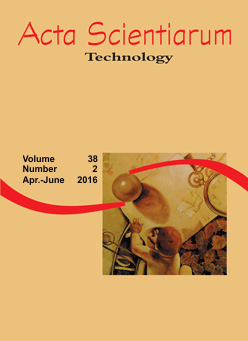<b>Assessment of the healing activity of jucá pods [<i>Libidibia ferrea</i> (Mart. ex Tul.) L. P. Queiroz] in cutaneous lesions of rats
DOI:
https://doi.org/10.4025/actascitechnol.v38i2.28570Palavras-chave:
medicinal plants, wound healing, healing activityResumo
The study aimed to evaluate the healing activity of the powdered pod of L. ferrea in cutaneous wound healing in preclinical test in rats. Eighteen rats were divided into two groups: the positive control group (PCG) treated with Kollagenase® and the experimental group (EG) treated with an ointment prepared with the powder of Libidibia ferrea. The lesions were clinically evaluated on 0 - 21st days, when histopathological analysis was also performed. In this study, the clinical analysis showed that although the rate of contraction of the lesions in EG was lower than in PCG, there was significant reduction in the wound of the group treated with ointment obtained from the powder of L. ferrea. Furthermore, the morphometric data showed that from the 3rd to 21st day after operation, the EG presented significant reduction in the rate of contraction of the skin lesions. Histological analysis revealed that the clinical and histological parameters of EG were similar to PCG. Although the biological activity of the powder remains unclarified, our results clearly showed the wound healing with the use of the powder of the pod of Libidibia ferrea in skin lesions. These finds provide subsidies for a similar research.
Â
Â
Downloads
Downloads
Publicado
Como Citar
Edição
Seção
Licença
DECLARAÇíO DE ORIGINALIDADE E DIREITOS AUTORAIS
Declaro que o presente artigo é original, não tendo sido submetido í publicação em qualquer outro periódico nacional ou internacional, quer seja em parte ou em sua totalidade.
Os direitos autorais pertencem exclusivamente aos autores. Os direitos de licenciamento utilizados pelo periódico é a licença Creative Commons Attribution 4.0 (CC BY 4.0): são permitidos o compartilhamento (cópia e distribuição do material em qualqer meio ou formato) e adaptação (remix, transformação e criação de material a partir do conteúdo assim licenciado para quaisquer fins, inclusive comerciais.
Recomenda-se a leitura desse link para maiores informações sobre o tema: fornecimento de créditos e referências de forma correta, entre outros detalhes cruciais para uso adequado do material licenciado.















